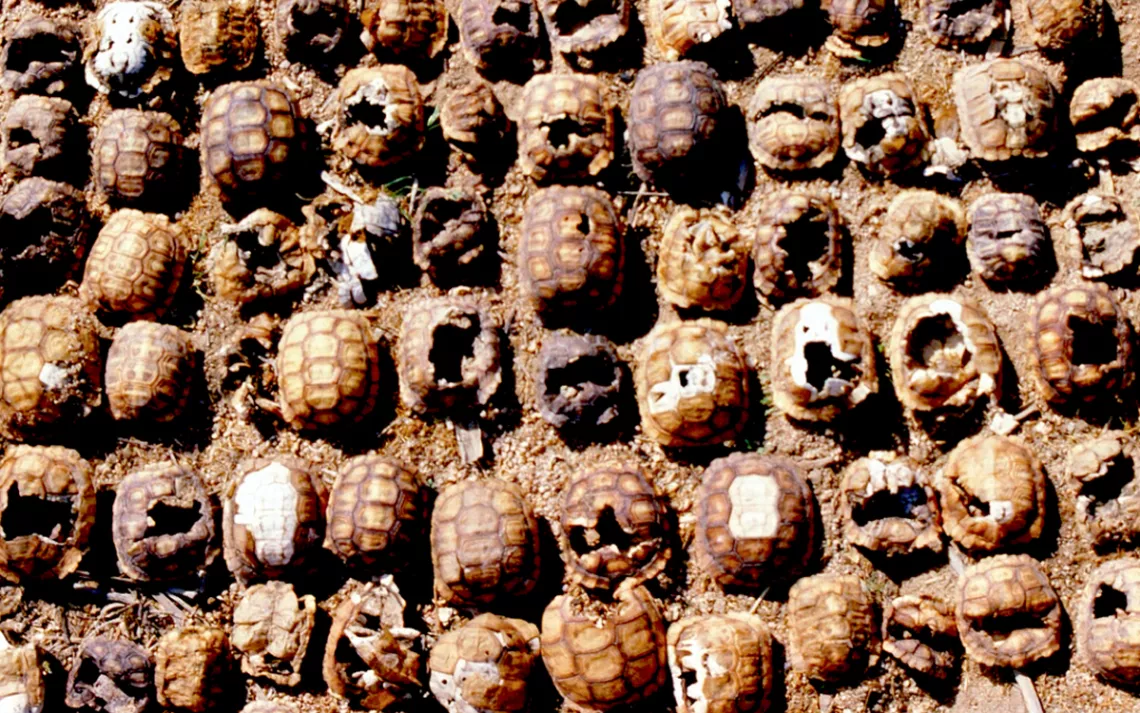Weaponized Juvenile Techno-Tortoises
The gamification of desert tortoise protection

Photo by Peter Woodman
There was a dead tortoise in my car.
She had survived 50 years in the Mojave Desert, the hottest and driest desert in North America, growing from a two-inch hatchling to a fully armored 12-pound beast on a diet of tiny wildflowers, cacti, and dried plants. She and her ancestors had roamed this land for 15 million years, but California's historic drought likely killed her. Tortoise conservationist Tim Shields and I were bringing her carcass to a makerspace in Barstow. There, his company, Hardshell Labs, could create a 3D-printed model of her—a "techno-tort"—that could be used in experimental tortoise conservation.
Along with drought, ravens are a major threat to desert tortoises, having learned that juveniles make a tasty snack (their shells don't fully harden for five to eight years). Though ravens are native to the Mojave Desert, their numbers have exploded as they have followed humans into this inhospitable terrain. "Look at this place from the point of view of a raven," Shields said, gesturing toward the scattered homes and crumbling shacks in the scrubby desert outside Joshua Tree National Park as we drove by. "Ravens in the numbers we're seeing would not hack it out here without humans. The only water in many of these valleys is from humans. They know they can get a drink and some shade at each of these structures. I've seen a couple of roadkills just this morning; each one creates a reliable cafeteria for them." He shook his head and sighed. "Ravens are ecological vacuum cleaners. We've imported mobile, highly motivated, highly intelligent, adaptable predators into prime desert tortoise habitat. It's an eco-systemic disaster."
Since Shields began studying these tortoises in 1978, their numbers have declined by 95 percent. One time, a biologist found 136 tortoise corpses under a single raven nest. Once distributed widely through the desert, tortoises now cling to isolated spots in scattered, remote locations. Raven numbers, by contrast, have increased by at least 1,500 percent in the past 40 years. Flocks in the hundreds gather where food, water, and shade are plentiful.
Shields believes that managing ecosystems is now a human obligation. "I sympathize with the sentiment that when humans start messing around with stuff, we screw it up," Shields said. "But I've put hundreds and hundreds of raven-killed baby tortoises into plastic bags. Ravens could wipe tortoises right off the planet and not skip a beat. If we don't do something, if we don't intervene, we will lose the desert tortoise over most of its range. 'Letting nature take its course' means sharing a planet with only domesticated animals and species that that can live off our subsidies."
So Hardshell Labs has pioneered the field of nonlethal avian management, disrupting raven roosting sites and protecting isolated desert tortoise habitat. For example, technicians will station a techno-tort in prime habitat on top of a hidden cylinder. When hungry corvids approach and start pecking at the "shell," they're sprayed by a cloud of synthetic grape juice—harmless for other desert dwellers but like pepper spray for a raven. In the lab, we watched videos of techno-torts spraying and ravens fleeing. Hardshell has weaponized juvenile tortoise models.
Other tools in the avian-management arsenal are raven-repelling lasers and drones that spray oil on raven eggs, preventing them from hatching. After repeated oilings, ravens abandon nesting sites near tortoise hot spots. On the road with Shields, we did a drive-by laser shooting of ravens roosting at a dairy, scattering hundreds in an instant. The birds' ultrasensitive vision means they respond to lasers that human eyes can barely detect; follow-up studies have revealed no damage to their sight. Stationary lasers at high-density locales have the potential to disrupt large gatherings of ravens. But who would operate them? "Agriculture, waste management, utilities—anyone can be an ally in preserving desert tortoises," Shields said.
Add gamers to the list of potential allies. Using portable, solar-powered internet nodes, Hardshell is enabling remote operation of its technology, making it potentially available to anyone with internet access, anywhere in the world. Unlike most online games, where players enter an alternate world, such games would open up the natural world. "We are a screen-based culture at this point. People view the world through screens," Shields said. "So how do we use those screens to recruit future environmentalists, particularly young people? We can bring people back to their planet through games."
Besides helping to protect the Mojave desert tortoise, Hardshell's games would offer players a chance to be heroes in real life. "I've talked to gamers about this, and their eyes light up," Shields said. "They know their game spaces are artificial constructs. They use games to escape from their world. Our games will be a reintroduction to the world, a chance to experience the joy and wonder of wild nature and help save endangered species without leaving their homes."
That joy, Shields believes, is the key to expanding the environmental movement. "If you look at any group of humans, once they achieve basic material security, they start playing games, making music, sitting around and telling stories. We pursue joy. It's universal." He paused. "We have to figure out how to make environmental action joyful."
 The Magazine of The Sierra Club
The Magazine of The Sierra Club



